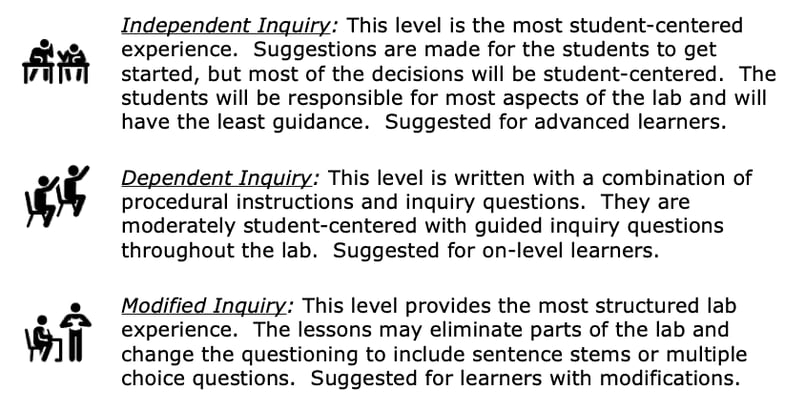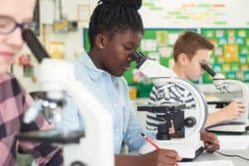Solids, Liquids, and Gases Inquiry Lab
Middle School Inquiry Lab on Solids, Liquids, and Gases
In this lab students will observe the effects of adding and removing thermal energy to a piece of wax.
Each inquiry lab will contain an essential question that will drive the lesson and make students think. For this lesson, the essential question is:
- What changes occur in particle motion, temperature, and the state of a pure substance when thermal energy is added or removed?
BACKGROUND INFORMATION AND MATERIALS LIST:
Students will begin the lab by reading the essential question and background information. This can be done individually, as lab groups, or as a whole class. If you consider lab groups, you also might include some type of whole class formative checks before digging into the lab.

Materials List:
- small beaker
- 2 large beakers
- ice
- 3 thermometers
- hot plate
- water
- heat resistant pads/gloves
- small piece of wax (about 2 cm tall, small enough to fit in small beaker)
PROCEDURE:
For this lab, students will set up multiple large beakers in order to see a state change for a piece of wax. First, students add water to two large beakers. One beaker will have ice added to it, while the other will be heated to a warm temperature.
Then students will add a piece of wax to the small beaker and place it into the larger one. Starting with the warm water, students set the small beaker inside and will record the state of the wax five minutes after it has sat in the warm water.
Students will repeat the same process, but instead, the second time will be in the beaker with the cold water. Again, after five minutes, students will record the state of the wax after it has sat in the cold water.
Finally, students will take this data and complete a flow chart indicating what it took to change the state of the wax piece.
CHECK FOR UNDERSTANDING:
At this point in the lab, students will be checked for understanding by answering questions about their findings. Here are a few that come with the lab:
- Which large beaker of water has the most thermal energy? Why?
- Describe the likely particle motion of the wax in its current state.
- When you placed the small beaker into the large, hot beaker, did you add or remove thermal energy from the wax?
- Describe the likely particle motion of the wax in its current state.
- When you placed the small beaker into the large, cold beaker, did you add or remove thermal energy from the wax?
- Describe the likely particle motion of the wax in its current state.
CONCLUSION
Students will go back to the essential question and write a CER (Claim, Evidence, Reasoning) to conclude the lab. Once completed, students will reflect back on their learning by answering the following questions:
- Why does adding thermal energy cause a change in the state of matter?
- What would happen to the liquid water in the hot beaker if you continued to add thermal energy?
MODIFIED AND INDEPENDENT INQUIRY VERSIONS
All of the Kesler Science inquiry labs come with three different modification levels. Each lab is differentiated using the icons below.

Download Over $100 in FREE Resources
For Middle School Science
Simply create a login below and gain immediate access to a selection of our Kesler Science product line worth $100 - for FREE. There's a full version of every product type! You'll also join tens of thousands of middle school science teachers who receive timely tips and strategies straight to their inbox.





